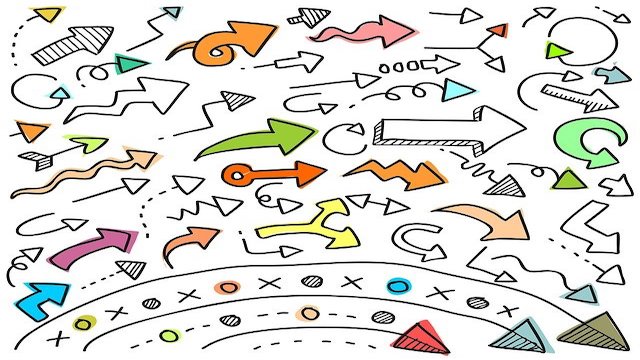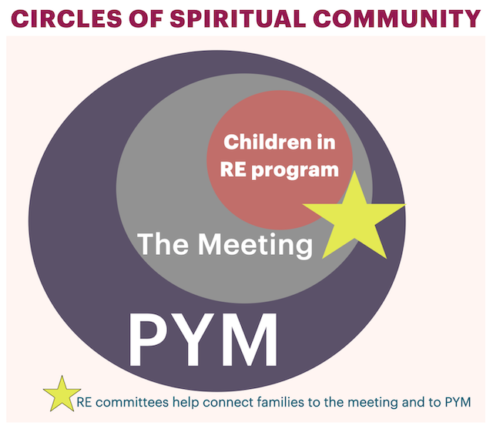
Queries from PYM Faith and Practice are read at the beginning of worship each month at my meeting; one of the youth in our Young People’s Group is the reader. In May, they were the ones about religious education: Nurturing Our Community: Religious Education in the Home and Meeting. As we think about returning to weekly programs for our children and youth, what guidance do these queries offer? This summer is a moment to pause and consider the experiences and lessons of these past months and how they might shape our programs and support for young Friends and families in our meetings. The PYM queries ask us is place in the center of our religious education programs preparation, formation, and belonging.
Simplified to their essence, the queries ask us to consider:
- Preparation of all ages for worship
- Preparation for all ages to live a life consistent with the principles of Quaker faith
- Formative learning that includes Friends’ history, practices and testimonies, the life and teachings of Jesus, and other religious traditions
- Experiential learning that enhances the sense of belonging to our worshipping community
Where do our meetings practices nurture preparation, formation, and belonging, and where might we consider ways to better align our religious education planning with the queries in Faith and Practice? How do the queries encourage us to re-think a “scholastic model” of “First Day School lessons” and to model support at home, at meeting, and in the Yearly Meeting for an all-ages spiritual community of life-long learners?
Tools for Planning
Part 1 of this story included suggestions about what we’ve learned in the last year+, including the importance of supporting spiritual nurture in the home, centering “why” in program planning, success with new models and schedules, and hope for more intergenerational connection. I also suggested that rest and reconnection will be important for Friends in returning to in-person community life.
The “What’s Next Planning Guide” is a practical tool for meetings to use as they think about where they’ve been in the last year and what’s next for their programs for young people. The questions lifted up in the guide are meant to help Friends focus on where the Light has been, and what feels possible with what we know at this time. There’s space to dream and also be very realistic. Focusing on community more than content in our planning may feel appropriate after the challenges of the last year, and aligns with preparation, formation, and belonging as our queries suggest.
We gave the questions in the Guide a test-run at a recent Youth Programs staff retreat, and found that they led us to grateful reflection and grounded planning. I hope it will be helpful to your meeting!
Another ready-to-use tool is the Planning Calendar for 2021-22 which includes links to Quaker religious education resources on the Quaker RE Collaborative website and has special dates noted (World Quaker Day is October 3rd!).
Fall Planning: Connection & New Directions is from last year, and while some of the Covid-related ideas are (thankfully) less relevant, the suggestions for supporting families, exploring “why” in flexible planning, and nurturing circles of multigenerational spiritual community are evergreen — and they align with preparation, formation, and belonging!
Where can all-ages meeting for worship fit into your plans? A Recipe for Multigenerational Worship provides guidance and encouragement for this vital experience of belonging to one another when we gather.
An Invitation: Building the Quaker Community We Want to Be
Announcing the Youth Programs theme for the coming year, and the hope that local meetings will consider our invitation to collaborate and use this theme in some way in your ministry with children and youth! How can we all model preparation, formation, and belonging in our programs, build bridges between local meetings and the wider PYM community, and nurture our young people feeling authentically connected to the Quaker Way? Watch for more specific curriculum resource-sharing this summer, to support interest in thematic planning between our circles of spiritual community.

“Building the Quaker Community We Want to Be” will show up in different ways in the Children & Families, Middle School Friends, and Young Friends programs. Staff are excited about plans for the coming year, which include resuming the monthly online Giant Children’s Meeting and Youth-led Meeting for Worship programs in September. The Youth Programs calendar will be published in time to share at Annual Sessions; carefully-planned opportunities for in-person gathering at appropriate times are on it.
We hope Friends will share invitations to Youth Programs with the families in their meeting, and that by connecting their formative experiences in the local and Yearly Meeting communities, our young people will experience a deeply grounded sense of belonging.
Questions about Safety
In the questionnaire responses from meetings there were many concerns expressed about masks and vaccines with children and youth in our all-ages communities. What will actually be possible in the Fall? There is uncertainty we’re all holding. We do know that young people are pretty tired of online programs, and during good weather being outdoors has made in-person programs possible (and joyful).
In addition to following CDC and state guidelines, and the careful discernment each meeting will do for their own community, this is a place where our community of practice can be a support. Watch for announcements about RE Conversations and “open office hours” to create spaces for sharing ideas and loving support for Friends who care for children and youth in their meetings.
Onward, Together.
Resources, collaboration, mutual support — We have these in PYM, alongside those queries that encourage a focus on preparation, formation, and belonging in our religious education programs.
When we consider the spiritual condition of our local meetings and our Yearly Meeting, we might also ask the query: “How are the children?” This question is one part of the traditional greeting of the Maasai people of east Africa; the children’s well-being is an indication of how well the community is faring. This seems obvious in a societal context, but what about in a faith community? I’ve heard sadness and worry that because of the pandemic, families have been less present in meetings — Will they come back?
That’s really up to us, Friends. Let’s begin by recognizing (as many do!) that children and youth are not the future of Quakerism, they are part of the body now. Let’s ask families what they need to participate (hint: child care is going to be on the list). Let’s be open to what we’ve learned from the pandemic and discern what new ways of doing things we tried and want to continue. Let’s ask ‘why” we do the things we do, re-ground ourselves in those truths, and reject “that’s the way we always do it” as the only reason to do anything! Together, let’s create for our children a multigenerational Yearly Meeting that is grounded in vital local meeting experiences, and where belonging to our worshipping community is preparation to live a life consistent with the principles of our Quaker faith.
Birmingham Meeting’s reflection on the past year and what’s next in their programs for young people expresses what is on many of our hearts so well:
“Our community has changed because of the pandemic. Our circle has widened as we have welcomed newcomers from near and far, and our capacity to reach each other and be in community has grown. As COVID restrictions ease, we look forward to new opportunities for exploring, discovering, learning, and growing together in the Quaker Way.”